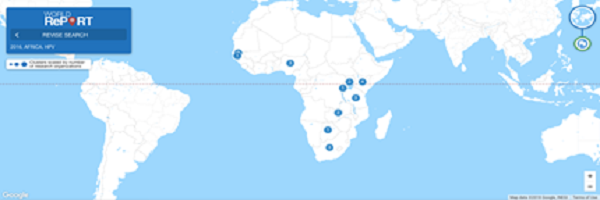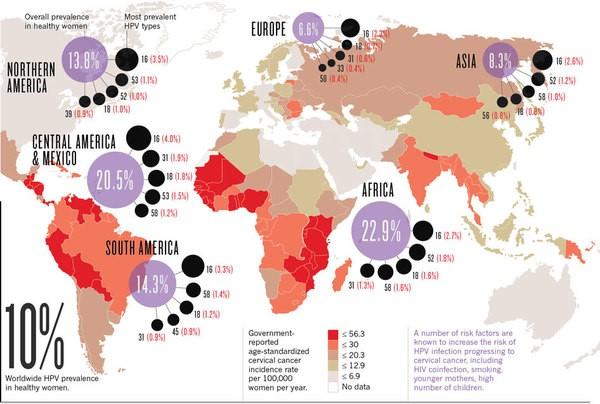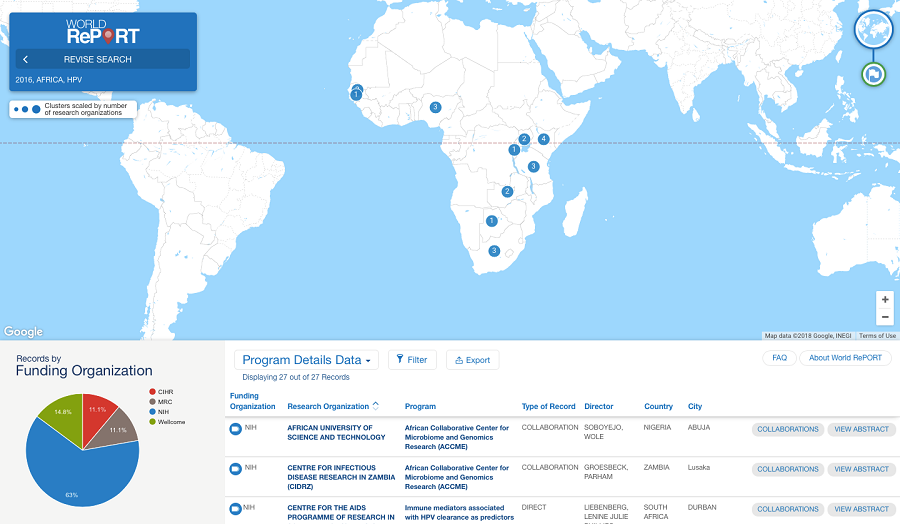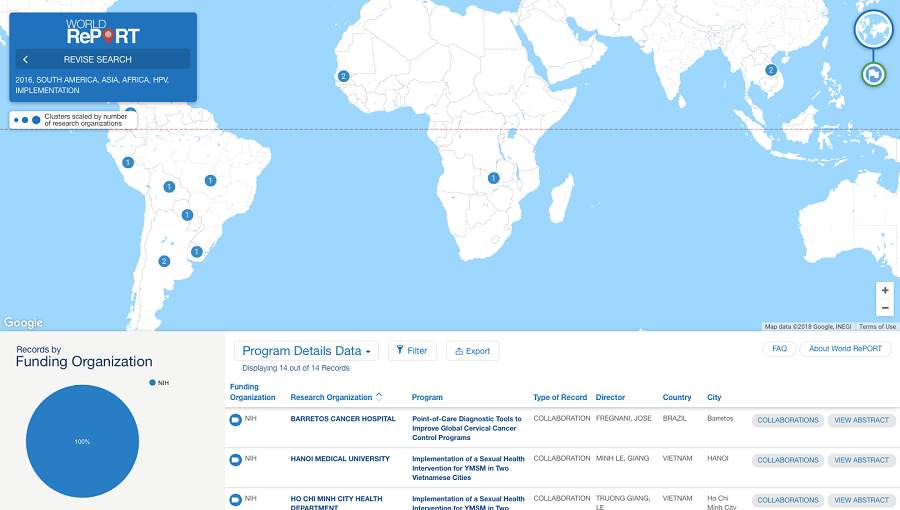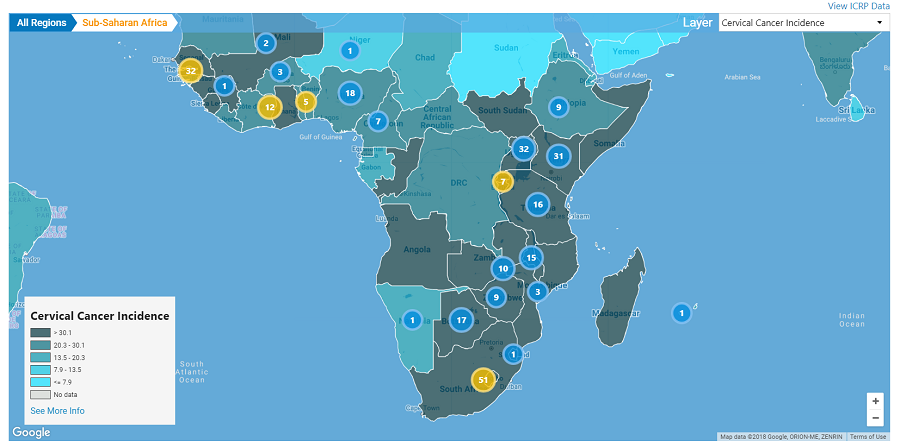Using World RePORT to Measure How Much HPV-related Research is Being Funded Throughout the World
, by Aliya Klein, Rachel Abudu, and Kalina Duncan
Aliya Klein was a 2018 summer Cancer Research Training Awardee at the Center for Global Health. In this blog, she documents how she used World RePORT, an open-access and interactive database of international research projects, grants, and collaborations dedicated to improving health, to answer questions about HPV-related research funding.
Each year, more than half-a-million women around the world are diagnosed with cervical cancer, and approximately 84% of these cases occur in low- and middle-income countries (LMICs). Research supported by the U.S. National Cancer Institute (NCI) has determined that human papilloma virus, or HPV, is the leading cause of cervical cancer. Researchers have developed vaccines that, if distributed and delivered comprehensively, would prevent 90% of cervical cancers worldwide (HPV and Cancer, 2015). Though the World Health Organization (WHO) recommends that countries give the HPV vaccination to all girls, as of October 2016, only 12 low- and middle-income countries had included this vaccine in their national vaccination plans (see Lessons learnt from human papillomavirus (HPV) vaccination in 45 low- and middle-income countries, 2017).
Disseminating the HPV vaccine in LMICs can be challenging, as skepticism, stigma, lack of access, and lack of funding are widely prominent. Additionally, anti-vaccination movements in some high-income countries have also brought negative attention to HPV vaccinations and have consequently lowered vaccine uptake in these countries (see Literature review of HPV vaccine delivery strategies: Considerations for school- and non-school based immunization program, 2014). There are success stories too: Australia and Rwanda have a national coverage rates for HPV vaccination of more than 90%, and the US has a national coverage rate of 50%. However, many countries still struggle with the challenge of establishing national vaccination plans as well as funding screening and prevention research on cervical cancer. Implementation science research is an important tool for developing locally-relevant and successful national HPV vaccination plans, and it is critical that this research be conducted in LMICs with high cervical cancer burdens.
On May 19, 2018 the WHO Director, Dr. Tedros Adhanom Ghebreyesus, issued a call to action for cervical cancer. Additionally, the U.S. NCI Designated Cancer Centers endorsed a similar goal of eliminating all HPV-related cancers through vaccination and screening in June 2018. Given this recent focus on HPV and its effects, it is important to consider the current research funding in regions with the highest incidence rates of cervical cancer, asking a few over-arching questions:
- Where are cervical cancer incidence rates highest?
- Where is HPV-related research funded?
- Where is the overlap between cervical cancer incidence and HPV-related research, and where are the gaps?
World RePORT, an open-access and interactive database of international research projects, grants, and collaborations dedicated to improving health, compiles data submitted by the U.S. National Institutes of Health (NIH), the UK’s medical research council (MRC), the European Commission (EC), the Canadian Institutes of Health Research (CIHR), the Bill and Melinda Gates Foundation, and the Wellcome Trust. We use this database to determine where research on HPV is taking place.
Global HPV Incidence
To determine which regions have the highest HPV incidence rates, I first took a look at a graphic posted by a Viral Infections Blog, which shows that high HPV incidence is concentrated in Central America, northern and western South America, and South and Southeast Asia, with the highest incidence rate (22.9% of reported women infected by HPV globally) occurring throughout sub-Saharan Africa, peaking in West and East Africa. When we look at 2012 IARC GLOBOCAN data for cervical cancer incidence, we see these same regions also have the highest cervical cancer incidence.
I began my search in World RePORT by examining the 2016 data using the search terms “HPV” or “human papilloma virus” to identify project abstracts with a matching term. I conducted two searches: one looking at the number HPV-related research projects in North America (I will use this as my comparator data set), and another looking at the number of HPV-related research projects in high HPV burdened continents (Africa, Asia, South America). For my analysis, I am defining North America as including Canada and United States only, and I have created a “Latin America” category that includes all countries from Latin America, Caribbean, and South America. I found 212 projects based in North America, and 36 projects with collaborators from Africa, Asia, and Latin America. In this analysis, I included supplements in my distinct project count.
| HPV-Related Research Projects in World RePORT | Total # of Projects | Total # of Projects focused on Cervical Cancer | Total # of Projects focused on Implementation Research | Total # of Projects focused on HPV or Cervical Cancer Screening Research |
| in North America (United States and Canada) | 212 | 96 | 21 | 54 |
| in Africa, Asia, and Latin America | 36 | 19 | 6 | 14 |
| Africa | 18 | 12 | 2 | 6 |
| Asia | 10 | 1 | 1 | 3 |
| Latin America (Central and South America) | 8 | 6 | 3 | 5 |
HPV-Related Research in Africa
I found 18 projects with African collaborators. I then searched for projects that had the keywords “HPV” and “cervical cancer” and found 12 resulting projects. The majority of HPV-related projects with collaborators in Africa are funded by NIH (12 of 18); other funders include Wellcome Trust (3), the Medical Research Council in the UK (2), and the Canadian Institutes of Health Research (1).
As displayed by the map, most projects have collaborators in Kenya, Tanzania, Senegal, and South Africa. This could be attributed to a number of factors including: strong in-country research capacity and existing collaborations with NIH and other partner institutions. The map also highlights gap in research funding in northern and central Africa.
HPV-Related Research in Latin America and Asia
After searching for HPV-related projects with collaborators in Africa, I moved onto Latin America. Latin America yielded 8 projects, and 6 focused on HPV and cervical cancer. Latin America’s HPV projects make up only 8 of the 245 HPV projects in World RePORT, despite it being the continent with the second highest HPV incidence rate in the world (Viral Infections, 2018). Like the HPV-related projects I found with collaborators in Africa, 6 out of 8 projects received funding from NIH.
I then proceeded to search for records under the keyword “HPV” in Asia, keeping in mind that the continent’s most concentrated HPV prevalence area is in the southeast. The results showed 10 projects, mostly located in China, Thailand, and Vietnam - all areas possessing a multitude of collaborations and strong partnerships with many cancer research centers worldwide. I found only one project record in India, which is noteworthy because India has one of the highest HPV infection rates in the region. Also, only 4 of the 10 projects focused on HPV and related cancers (mainly head and neck cancer research), and one project focused on HPV and cervical cancer.
HPV-Related Projects Focusing on Implementation Science
Within these records, I also examined how many projects described using implementation science, as research in this field can contribute to more effective policies and programs in regions that lack resources for HPV vaccine implementation. I filtered the World RePORT database by using the terms “HPV” AND “implementation”, looking only at the continents with the highest disease burden (Africa, Latin America, and Asia). I found 6 projects, all funded by NIH. Of these 6 projects, 3 had collaborators based in Latin America.
HPV-Related Screening Projects
I wanted to investigate how many HPV-related projects focused on cervical cancer screening or not. A search of World RePORT with the keywords “HPV” AND “screening” and a cursory abstract review yielded more optimistic results, resulting in 14 projects spread across the three regions (even though most projects still were located in Latin America). All of the screening projects I found were funded by NIH. Though the number of screening projects I found is limited, it appears that these projects include collaborators located in regions with high HPV disease burden. For example, cervical cancer incidence is high in Eastern Africa, and I found three screening projects with collaborators in Rwanda, Uganda, and Tanzania (one project each).
Comparison to Data in the International Cancer Research Partnership (ICRP) Database
To add to my results from World RePORT, I used the same methodology to search through the International Cancer Research Partnership (ICRP) database for relevant projects. ICRP is a global partnership of over 120 cancer research funders, with an interactive database and map of ICRP funder projects. The most current year of complete partner data in ICRP is 2015, and so I gathered project data from 2015 to compare to my 2016 World Report analysis. Additionally, it is worth noting that currently, the majority of international collaborator data found in ICRP is for NIH only.
Using the search term “HPV” in ICRP’s keyword search, I found 382 matching projects. Only 18 of these projects (4.7%) had collaborators from high incidence regions (South America, South Asia, East Asia, and Sub-Saharan Africa). Although ICRP is a database comprised of different partner representatives than those listed in World RePORT, these findings support my observation and findings from World Report that there is generally a relatively low number of research projects in LMICs with high HPV incidence.
Summary
While I only performed a quick overview analysis using World RePORT, my results provide a few important conclusions. I was able to quickly identify where HPV-related research projects are located around the world and I found that there is a notable difference between the number of HPV-related screening and implementation projects with collaborators in regions with a high burden of HPV incidence, when compared to the number of matching projects with collaborators or PIs from high-income countries with low burden of HPV incidence, such as North America.
It is important to note that World RePORT only includes projects funded by high-income countries, and I could be missing HPV-related research projects that are funded by local governments and organizations in LMICs. Additionally, my analysis identified relevant projects through the presence of certain keywords in the project abstract, and I may be missing projects that include HPV-related research as a secondary or tertiary aim of their project. While World RePORT does not necessarily reflect all current research activity, it does serve as a helpful, open-access method of gathering data to begin to answer important questions about international health.
